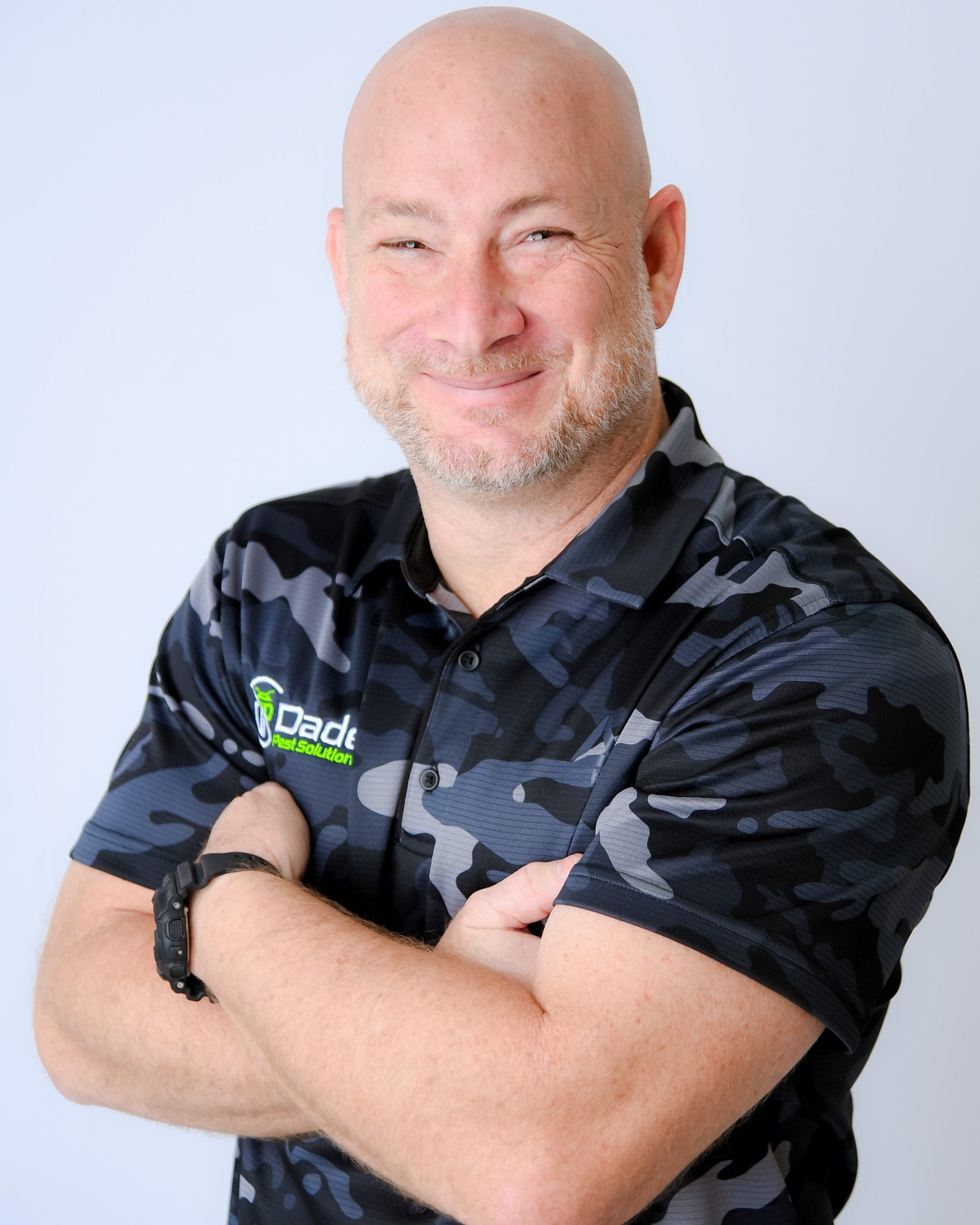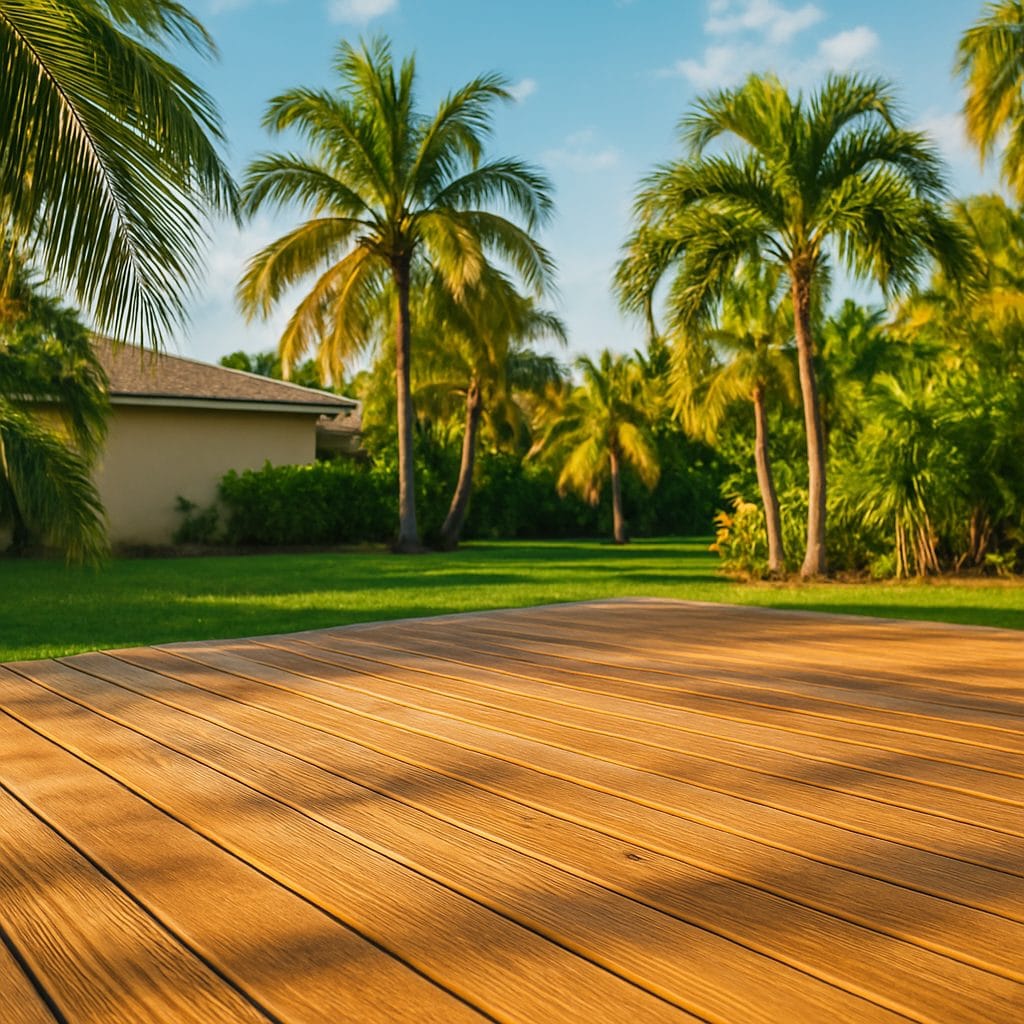like stepping onto your deck on a warm evening with a glass of lemonade and feeling that smooth lumber beneath your feet. Unfortunately, Miami‑Dade’s climate is also paradise for termites. Without regular maintenance and the right prevention strategy, your beautiful deck can quickly become a buffet for drywood or subterranean termites. Local homeowners and property managers frequently ask our technicians at Dade Pest Solutions about the best termite treatment for wood decks in Miami and how to keep those outdoor living spaces pest‑free. In this guide we’ll dig into why decks attract termites, how to spot early warning signs, and which treatments and prevention methods work best in south‑Florida’s environment.
Keeping a wooden deck in prime shape is one of the joys of South‑Florida living. There’s nothing
Why Miami Decks Attract Termites
Miami‑Dade’s tropical climate delivers the heat and humidity termites need to thrive. Formosan and eastern subterranean termites prefer moist soil and wood with moderate moisture, while drywood termites live inside the wood itself and don’t require contact with the soil. Florida’s year‑round warmth means termite colonies can reproduce and feed continuously, causing billions of dollars in structural damage each year. When you build a deck, you create a perfect environment: exposed wood, often close to the ground, shaded corners where moisture lingers, and easy access from landscaping or mulch. Even pressure‑treated lumber can become susceptible over time if the protective chemicals leach out or the wood stays damp.
Local Termite Species
Two groups of termites cause most of the deck damage in Miami:
- Subterranean termites build large colonies underground and travel through mud tubes to reach wood. They need soil moisture to survive, and their colonies can forage across an acre or more. Formosan subterranean termites, an aggressive species introduced from Asia, are present throughout South Florida.
- Drywood termites live entirely inside the wood they consume. They require far less moisture and often infest decks, fascia boards and attic timbers. They leave behind piles of pellet‑like frass (droppings) and kick‑out holes.
Knowing which type is attacking your deck helps determine the most effective treatment. When in doubt, collect a sample and submit it to the UF/IFAS Fort Lauderdale termite lab for free identification.
Signs of Termite Damage in a Wood Deck
Termites eat wood from the inside out, so you won’t always see them until significant damage has occurred. Look for these red flags during your regular deck inspections:
- Soft or hollow‑sounding boards: Tap the boards with a screwdriver; hollow spots often indicate internal galleries.
- Mud tubes: Subterranean termites build pencil‑sized mud tunnels along concrete foundation walls or deck posts. Fresh tubes are moist and will be repaired quickly if disturbed.
- Bubbling paint or peeling stain: Termite damage can mimic water damage and may appear as blistered paint or lines under a deck finish.
- Dropped wings or frass: Swarming termites shed their wings after mating, and drywood termites push piles of pellet‑shaped droppings (frass) out of kick‑out holes.
- Stuck doors or warped rails: Damage to wooden framing can cause deck gates or rails to swell or warp, making them difficult to open.
If you notice any of these signs, it’s time to take action right away. Termite colonies never stop eating, and delay only increases repair costs.
Choosing the Right Treatment
Not all termite treatments are created equal. The best solution depends on the species involved, the extent of the infestation and whether you prefer chemical or non‑chemical options. Below is a summary of common treatments with pros, cons and suitability for wooden decks.
Borate and Wood Hardener Treatments
Borate products penetrate wood fibers and make the wood inedible and lethal to termites. They’re excellent for treating new lumber before construction or protecting replacement boards during repair. Products such as Bora‑Care® can be brushed or sprayed onto raw wood. For existing decks, you’ll need to sand off paint or stain first so the borate can soak in.
Wood hardeners can reinforce damaged boards. They don’t kill termites outright, but they make softwood denser and less attractive to drywood species. Use them when small sections of a board have been chewed but the majority of the board is still structurally sound.
Heat, Cold and Microwave Treatments
Localized heat treatment raises the temperature of infested wood to levels that kill drywood termites without chemicals. It’s environmentally friendly but best for small, contained areas; achieving lethal temperatures throughout an entire deck can be difficult.
Cold treatment exposes infested wood to extremely low temperatures. Like heat treatment, it works well for small objects or localized infestations. Miami’s climate makes outdoor cold treatments impractical, but a pest‑control company might use liquid nitrogen for isolated structural elements.
Microwave treatments focus microwave energy on a small area of wood to kill termites. Because microwaves penetrate only a few inches, this method suits small sections of decking rather than entire structures.
Chemical Treatments
Professional termiticides remain the gold standard for subterranean termites. Liquid termiticides create a barrier in the soil around the deck; the colony dies off as termites pass through the treated zone. According to Native Pest Management’s Miami guide, liquid termiticides have high effectiveness and provide protection for five or more years. Bait stations are another option: workers carry slow‑acting bait back to the colony, eventually eliminating it. Spot treatments can target localized drywood or subterranean activity but require ongoing monitoring.
Fumigation & Tentless Treatment
For severe drywood infestations that extend beyond a single board, tent fumigation saturates the entire structure with a fumigant. You’ll need to vacate your home and remove plants and pets for several days. Tentless treatments, offered by Dade Pest Solutions, use targeted foam or dust to kill colonies without requiring you to leave the house. They’re often faster and less disruptive than tenting, though not appropriate for every situation. Our termite inspection & treatment service includes an assessment of whether tentless or fumigation methods will best eliminate your infestation.
Biological and Eco‑Friendly Options
Eco‑conscious homeowners sometimes explore biological controls such as beneficial nematodes or orange oil. Nematodes are microscopic worms that feed on subterranean termites, while orange oil products (containing d‑limonene) can kill drywood termites on contact. Native Pest Management notes that eco‑friendly options like nematodes may provide a tailored solution, but they rarely eliminate an established colony by themselves. Use them as part of an integrated pest‑management plan rather than a standalone fix.
Prevention: Keeping Termites Off Your Deck
Preventing termites is far easier (and cheaper) than treating an active infestation. Here are proven strategies to protect your deck in Miami’s climate:
- Build with pressure‑treated or termite‑resistant materials. Pressure‑treated lumber is infused with chemicals that deter pests. Alternatives like composite decking or naturally resistant woods (cedar, redwood) also reduce the risk of infestation. If you’re replacing boards, treat them with a borate solution before installation.
- Keep wood away from soil and moisture. Termites require moisture to survive. Ensure support beams rest on concrete footings rather than directly on soil. Add gravel or rocks under the deck to improve drainage, and fix leaky spigots or downspouts so water doesn’t pool near the structure.
- Seal and maintain your deck. Regularly clean off leaves and debris, seal cracks where moisture might accumulate, and reapply a water‑repellent sealer every few years. A clean, dry deck is far less attractive to termites.
- Limit wood‑to‑ground contact elsewhere in the yard. Store firewood several feet away from the house and off the ground. Remove dead tree stumps and roots, and avoid mulching right up against the deck or foundation.
- Install physical barriers for new construction. Sand barriers or steel mesh installed under the deck can physically block termites. These are most practical when you’re building or replacing the entire deck structure.
- Schedule regular inspections. Annual termite inspections by a licensed professional are crucial. Professionals can spot early signs and provide proactive treatment before major damage occurs.
DIY vs. Professional: When to Call the Experts
Small, isolated drywood infestations can sometimes be handled by homeowners using borate treatments and diligent repairs. However, subterranean termites live in large colonies that are almost impossible to eradicate without professional equipment and insecticides. A licensed pest‑control company has the experience to identify the species, locate all affected areas and deploy the appropriate treatment.
At Dade Pest Solutions, our local technicians serve Homestead, Pinecrest, Cutler Bay, and neighboring communities. We provide comprehensive termite inspection & treatment and termite fumigation services. We also offer preventive maintenance plans that include regular inspections and perimeter treatments so you can enjoy your deck year‑round without worry.
How to Treat a Termite‑Infested Deck: Step‑by‑Step
The following step‑by‑step process outlines how a homeowner or pest professional might tackle a termite problem on a deck. This framework can be incorporated into a how‑to schema for search engines.
- Confirm the infestation. Inspect the deck for signs (mud tubes, frass, hollow wood) and determine whether you’re dealing with drywood or subterranean termites. Collect a sample for professional identification if needed.
- Remove and replace severely damaged boards. Use a pry bar to lift boards that have lost structural integrity. Dispose of the infested wood in sealed plastic bags.
- Sand and treat salvageable lumber. If damage is minimal, sand the surface to remove paint or stain, then apply a borate solution evenly across the exposed wood. Allow it to dry completely.
- Apply soil barrier or bait stations (subterranean termites). Dig a shallow trench around deck posts and footings. Mix and pour a liquid termiticide according to the label, or install bait stations at regular intervals.
- Seal cracks and install physical barriers. Caulk gaps between boards and where the deck attaches to your home. If you’re rebuilding, include metal flashing or mesh barriers beneath the posts.
- Follow up with inspection and maintenance. Monitor bait stations monthly, reapply borate after heavy rains, and schedule professional inspections every year to catch new activity early.
Frequently Asked Questions (FAQ)
What is the best termite treatment for wood decks in Miami?
The most effective treatment depends on the species and severity of the infestation. For subterranean termites, soil‑applied liquid termiticides or bait stations provide long‑term control and protection. For drywood termites confined to a few boards, borate treatments, heat or spot‑applied foam can be effective. Severe drywood infestations may require fumigation. A professional inspection will determine the best approach for your deck.
Can I avoid tenting my house if termites are only in the deck?
Often, yes. Tentless treatments (also called no‑tent or spot treatments) inject foam or dust directly into infested wood. They’re less disruptive than fumigation and can solve localized drywood problems. However, if the infestation has spread throughout the structure, tenting may be the only option for complete elimination. Our team will explain your options during a free inspection.
How often should I inspect my deck for termites?
In Miami’s year‑round termite season, inspect your deck at least twice per year and after heavy rains or storms. Annual professional inspections are also recommended.
Which types of wood are naturally resistant to termites?
Cedar, redwood and teak contain natural oils that deter termites. Composite decking made from recycled plastic and wood fibers is also highly resistant. Even with these materials, proper maintenance and moisture control are still important.
Are DIY treatments effective against termites?
DIY solutions such as orange oil, diatomaceous earth or homemade bait traps may kill some termites on contact, but they seldom reach the colony. For small drywood infestations you can see and access, borate treatments can help. For anything beyond a minor problem, it’s best to hire a professional who can access commercial‑grade products and guarantee results.
Final Thoughts
Living in Miami offers endless sunshine and outdoor fun, but it also means sharing your environment with persistent pests. A wood deck adds beauty and value to your home, but it needs protection to withstand South Florida’s termite pressure. By recognizing the early signs of infestation, choosing the right treatment, and investing in preventive measures like moisture control and annual inspections, you’ll extend your deck’s lifespan and save on costly repairs. When in doubt, call the experts. Dade Pest Solutions is a locally owned company serving Homestead, Miami, and surrounding communities. We offer free estimates, provide honest advice, and treat your home as if it were our own. Contact us today to schedule a termite inspection & treatment and take the first step toward a pest‑free deck.
This article is provided for educational purposes and should not be considered a substitute for professional pest‑control advice. Always follow label directions on pesticides and consult a licensed professional if you suspect a termite infestation.

17 Years of Pest Control Experience Founder and Owner of Dade Pest Solutions Proud Resident of South Florida
Shaun Judy, a dedicated South Florida native, is the founder and driving force behind Dade Pest Solutions. With over 17 years of hands-on experience in the pest control industry, Shaun has built a reputation for reliability, results, and real local knowledge. His journey began with a deep commitment to protecting homes from pests using proven methods and innovative solutions. Raised with a strong work ethic and a passion for service, Shaun treats every property as if it were his own—delivering expert care with a personal touch.

